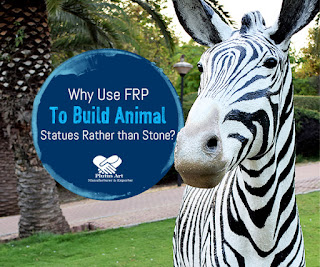Why Use FRP To Build Animal Statues Rather than Stone?
Have
you visited a museum or a zoological garden? Chances are that you
will come across statues of animals as props to inform people of the
type of animal present (in a zoo) and displayed (in a museum.) For
long, these statues were made of stone or metal but times seem to
have changed of late. Now, it is all about a new material called the
FRP or Fiber Reinforced Plastics. The tensile material is much more
resilient to elements like cold, wind, rain or sun besides being
attractive to view and light to carry. The kind of shapes FRP can be
moulded into is mindboggling. In fact, the material lends itself well
to all kinds of shapes that an artist can visualise, which a stone or
metal can never be able to replicate.
What
is meant by FRP?
Fiberglass Reinforced Plastics is
made by fusing fiberglass and resins through the process of heating.
The main ingredients of FRP are glass shards and fiberglass. And it
is the resin that binds the glass shards into a proper composite
laminate that is tough, resilient and flexible at the same time.
Besides acting as a binder, the resin provides corrosion and
environmental resistance to the final product.
Advantages
of FRP as a material
The popularity of FRP as a material
to build statues, sculptures, planters etc arises out of its many
benefits as mentioned below.
-
Corrosion and temperature resistant
-
Light in weight but strong in build
-
Can be moulded into any shape or size
-
A smooth internal surface
-
Easy to maintain and repair
Versatility
of FRP
Chiselling
a metal or stone into a specific form is a painstaking and time
consuming exercise not to speak of the cost involved. FRP, on the
other hand, is flexible enough to be moulded into any shape. So, be
it the jagged and sharp teeth of a crocodile, the free flowing shape
of an elephant trunk, the piercing gaze of a lion or the feathers of
an eagle, no matter what shape it is, the FRP
animal
can closely resemble the real one.
How
to get the animals made from FRP?
Developing an animal from FRP or
fiberglass material is an elaborate process that requires a
methodical approach, the use of deft hands and enough experience to
make things happen within the turnaround time. This calls for
engaging an experienced company that has the wherewithal and skilled
manpower to bring your dreams into reality. When it comes to the
works of art made from fiberglass including making animal statues
(even extinct ones like the dinosaur,) Plutus Art is a name to reckon
with. The company utilizes an innovative but effective strategy to
build statues from FRP.
-
The structuring process includes concrete binding.
-
The clients are sent updates on each phase of work especially when involving clay. The company is open to unlimited revisions from clients.
-
Post confirmation of clay work by the customer, the mould work begins.
-
The mould work is followed by casting, brassing, and cleaning.
-
The colouring part begins with applying the primer followed by final painting.
Conclusion
An
FRP animal
projects a lively appearance and can easily replace the ones made
from stone or metal. It has several advantages including cost
effectiveness. The ones made by Plutus Art stand apart for their
quality, cost and timeliness.




Comments
Post a Comment